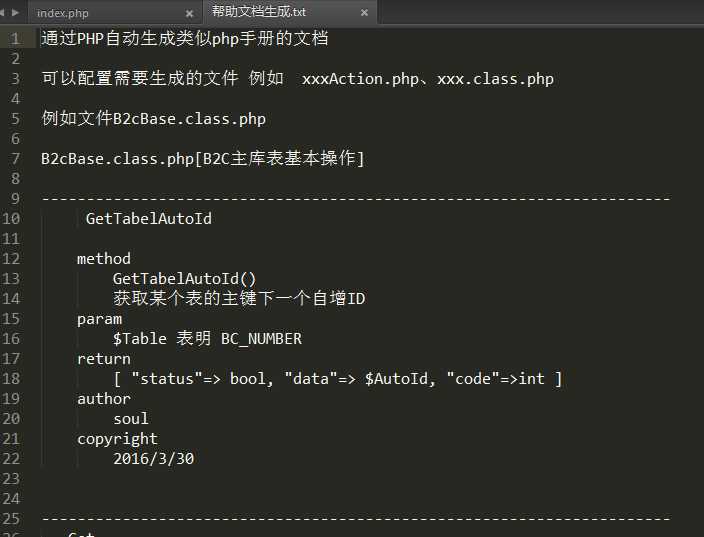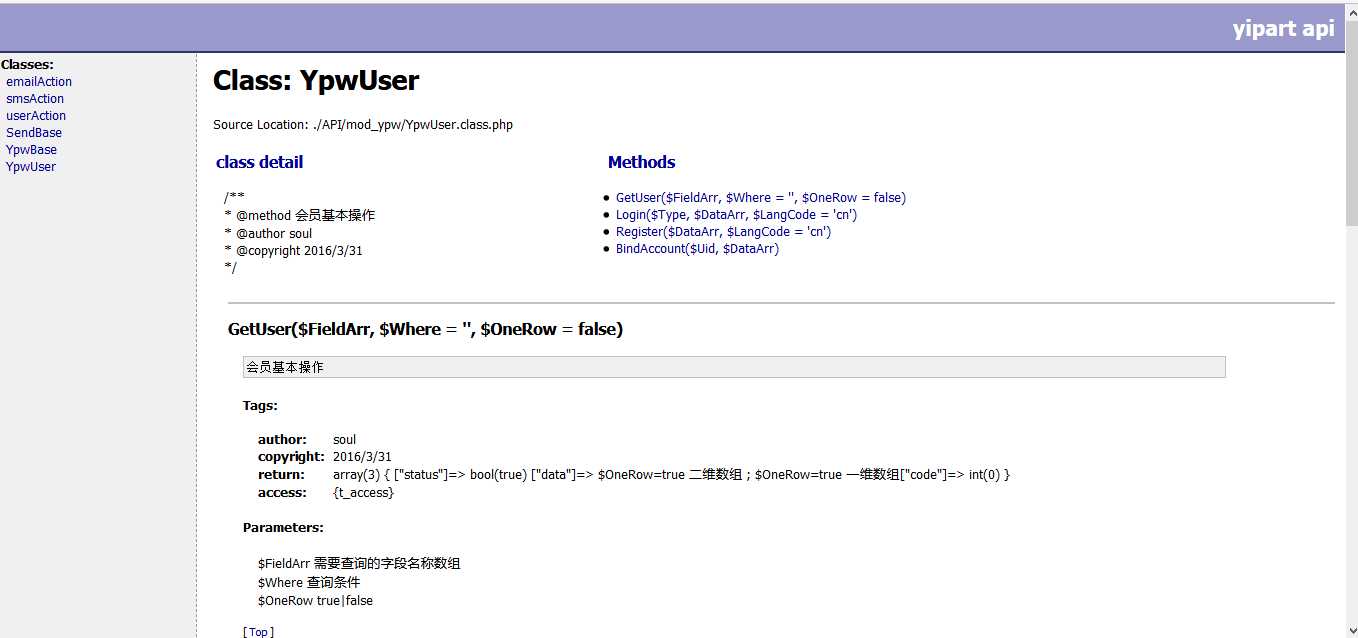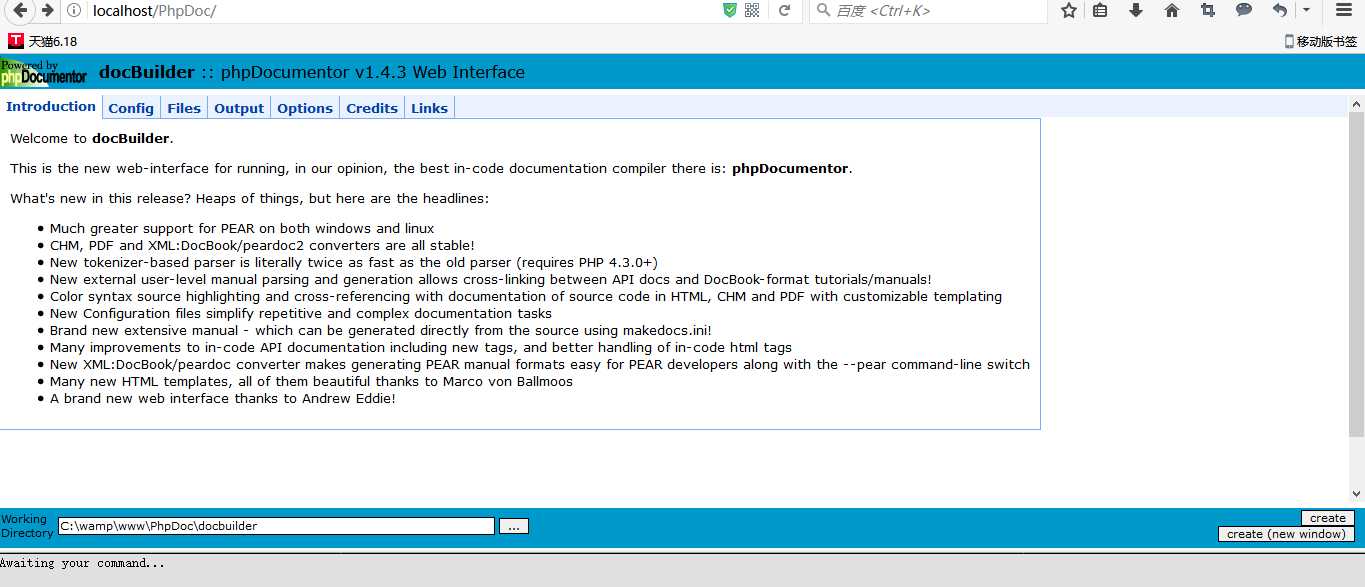PHP读取注释生成api文档
Posted
tags:
篇首语:本文由小常识网(cha138.com)小编为大家整理,主要介绍了PHP读取注释生成api文档相关的知识,希望对你有一定的参考价值。
总结就是,正则要用的好。
需要生成api的class文件:
<?php class emailAction { /** * @method 发送邮件 * @url email/send?token=xxx * @http POST * @param token string [必填] 调用接口凭证 (post|get) * @param ema_type enum [必填] 发送速度:‘普通‘,‘紧急‘,‘延时‘ * @param ema_from enum [必填] 来源:‘B2C‘,‘主站‘,‘客户网‘,‘CRM‘ * @param ema_from_email string [可选] 发送人邮箱 * @param ema_from_name string [可选] 发送人 * @param ema_to_email string [必填] 接收人手机号码,多个逗号分隔 * @param ema_title string [必填] 标题 * @param ema_text string [必填] 内容 * @param ema_style string [可选] 信息类型 例如:邮箱验证,取回密码.... * @param ema_expire_time int [可选] 过期时间戳,超过此时间即使失败也不再发送 * @author soul * @copyright 2017/4/13 * @return {"status":false,"data":‘失败原因‘,"code":0} */ function send() { $MustArr = [‘ema_type‘, ‘ema_from‘, ‘ema_to_email‘, ‘ema_title‘, ‘ema_text‘]; foreach($MustArr as $V) { if(empty($_POST[$V])) { echo LibFc::ReturnJson(false, $V.‘参数必填‘); exit; } }$SendEmail = new SendEmail(); $Res = $SendEmail->SendByIds([$Id]); echo json_encode($Res); } /** * @method 获取对应ID的信息 * @http GET * @param token string [必填] 调用接口凭证 (post|get) * @param ema_ids string [必填] 邮件ID,使用逗号(,)分隔 * @author soul * @copyright 2017/4/13 * @return {"status":false,"data":‘失败原因‘,"code":0} */ function get() { $Params = mvc::$URL_PARAMS; if(empty($Params[‘ema_ids‘])) { echo LibFc::ReturnJson(false, ‘邮件ID必填‘); exit; } $SmsIdArr = []; foreach(explode(‘,‘, $Params[‘ema_ids‘]) as $V) { $SmsIdArr[] = (int) $V; } echo LibFc::ReturnJson(true, $Arr); } /** * @method 发送指定ID的邮件 * @http POST * @param token string [必填] 调用接口凭证 (post|get) * @param ema_ids array [必填] 邮件ID * @author soul * @copyright 2017/4/13 * @return {"status":false,"data":‘失败原因‘,"code":0} */ function send_by_ids() { $Params = mvc::$URL_PARAMS; if(empty($Params[‘ema_ids‘])) { echo LibFc::ReturnJson(false, ‘邮件ID必填‘); exit; } $SendEmail = new SendEmail(); $Res = $SendEmail->SendByIds(explode(‘,‘, $Params[‘ema_ids‘])); echo json_encode($Res); } /** * @method 删除对应ID的邮件记录 * @http GET * @param token string [必填] 调用接口凭证 (post|get) * @param ema_ids string [必填] 邮件ID,使用逗号(,)分隔 * @author soul * @copyright 2017/4/13 * @return {"status":true|false,"data":‘‘,"code":0} */ function del() { $Params = mvc::$URL_PARAMS; if(empty($Params[‘ema_ids‘])) { echo LibFc::ReturnJson(false, ‘邮件ID必填‘); exit; } } }
生成的文件的代码:
<?php $url = ‘emailAction.php‘; $c = file_get_contents($url); echo ‘<meta charset="utf-8">‘; $tmp = ‘ {t_function} method {t_function} {t_method} param {t_param} return {t_return} author {t_author} copyright {t_copyright} ‘; $rege = ‘{method (.+)[\\s\\S]+?author (.+)[\\s\\S]+?copyright (.+)[\\s\\S]+?return ([\\s\\S]+?)\\*\\/[\\s\\S]+?function (.+)}‘; preg_match_all($rege, $c, $ms); $m_method = $ms[1]; $m_author = $ms[2]; $m_copyright = $ms[3]; $m_return = $ms[4]; $m_function = $ms[5]; echo ‘<pre>‘; $t = ‘‘; foreach($ms[0] as $i => $m){ $t_method = trim($m_method[$i]); $t_function = trim($m_function[$i]); $t_return = trim($m_return[$i]); $t_author = trim($m_author[$i]); $t_copyright = trim($m_copyright[$i]); $t_param = ‘‘; $rege = ‘{param (.+)}‘; $rege = ‘{param ([\\s\\S]+?)\\* \\@}‘; if(preg_match_all($rege, $m, $mm)){ $tmpPP = $mm[1]; $t_param = implode("\\n ", $tmpPP); } $t.= str_replace( array(‘{t_method}‘, ‘{t_function}‘, ‘{t_return}‘, ‘{t_author}‘, ‘{t_copyright}‘, ‘{t_param}‘), array( $t_method , $t_function, $t_return, $t_author, $t_copyright, $t_param), $tmp ); $t.=‘-----------------------------------------‘ ."\\n"; } echo $t; file_put_contents($url.‘.txt‘, $t);
生成文件的样子:

这个是最初的版本,实际的情况,对整个项目进行文件生成api文档,需要遍历文件,生成html形式帮助文档的话需要引入模板,并赋予数据:
最终的样子:

另外:实际开发之中如果注释严格按照PhpDocumentor的文档要求的规范去注释的话,是可以直接用PhpDocumentor工具去生成api文档的,将其代码下载下来在localhost上可以直接运行,有web页面去生成帮助文档,web页面示例:

官网:
http://pear.php.net/package/PhpDocumentor/
web界面填写需要生成帮助文档的文件路径、输出的文件路径,生成的帮助文档模板选择,如果需要个性化定制,对于源码很无奈,现在还看不懂,只能对模板进行更改,需要注意的是,localhost运行的时候需要改动一下phpdoc.bat这个文件里面的php.exe对应的路径。
以上是关于PHP读取注释生成api文档的主要内容,如果未能解决你的问题,请参考以下文章